"A normal, fun activity" – An interview on participatory research and the importance of accessibility for everyone
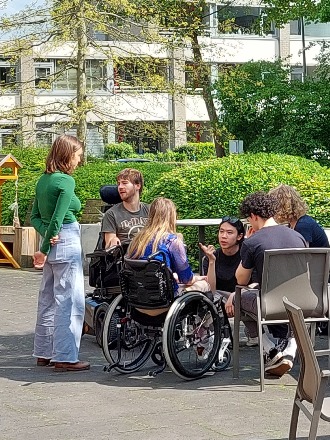
In this interview, Bettina van Hoven and her research team, including co-researcher Leon Lodder, who lives at a residential home for people with disabilities, delve into the world of participatory research. They talk about the transformative power of involving communities in their research, and shed light on their current NWO-funded project “Everyday Geographies and Being and Becoming Disabled”. Focusing on the everyday experiences of people with disabilities, this project utilises community-based participatory research to foster inclusion and understanding in urban settings.
Leon shares his personal insights as a co-researcher, providing a unique perspective on the challenges faced by wheelchair users in Groningen. By highlighting the importance of building trust, fostering dialogue, and creating actionable solutions that can enhance accessibility in everyday life, this interview not only showcases how community-based research looks like in practice but also emphasises the human connections that lie at its heart.
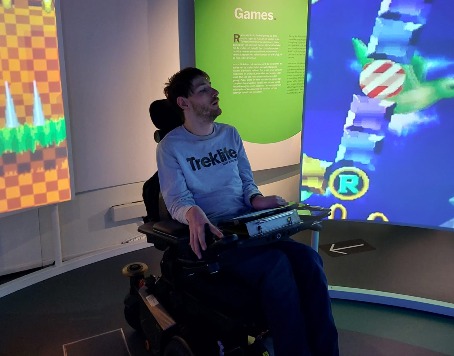
About Leon Lodder:
Leon is a resident at ‘s Heeren Loo. Since 2015, he has worked alongside Bettina on numerous projects. Their collaboration has included co-teaching lectures at the University of Groningen (UCG) and developing a webinar for SNN during the pandemic. Additionally, they organised in-person meetings for secondary school students as part of the college carousel initiative. Leon has cerebral palsy, which means he experiences muscle cramps and he cannot walk or speak. Leon makes use of a wheelchair and a manually operated speech computer, which is why his responses in the interview may be brief.
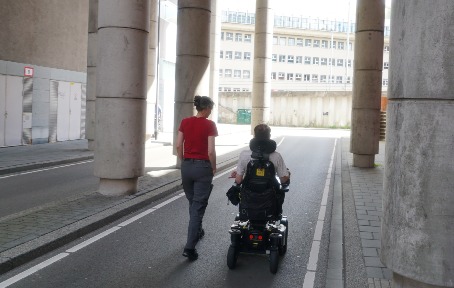
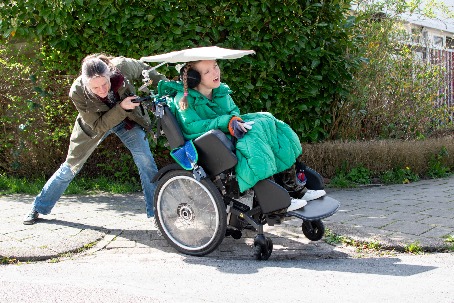
Bettina, when did you first start engaging in participatory research? What does your participatory research look like, and what inspired you to pursue it?
Bettina van Hoven: I started engaging in what we'd now call participatory research back in the late nineties. At the time, we didn’t have a name for it. Participatory research can vary in terms of how involved the target group is. At the lower levels, it might just mean asking for their opinions. But at the higher levels, they’re involved in everything—from identifying the problem to collecting and analysing the data. When I did my PhD in the nineties, I was studying the experiences of women in East Germany after reunification. I didn’t realise it at the time, but I was already using participatory methods. I did a group interview, but as we talked, it became clear that the conversation was going in directions I hadn’t anticipated. So, as a group, we decided to walk around the village together. They guided me, showing me what was important to them, and I would ask questions based on what we encountered. Looking back, that was really the beginning of my participatory approach—letting the group lead and checking with them about what mattered most, and how we should explore it.
When you began, you were one of the few researchers involved in participatory research. What challenges did you face along the way, and why did you decide to continue despite these obstacles?
Bettina van Hoven: When I moved here after doing my PhD in the UK, doing gender research was seen as unnecessary. People thought the gender issue had already been 'solved,' and topics like embodiment, small spaces, and everyday lives weren’t considered part of geography. It was hard to find support, so I shifted my focus for a while. Another challenge is the time and effort participatory research requires. Institutions often expect quick results for publications and rankings. In reality, building trust, especially with marginalised groups, takes time. It’s not about parachuting in, extracting data, and moving on. You have to invest in relationships and adjust along the way. But over the years, things changed as research became more international. I noticed that at international conferences, there were more people from Dutch universities, and ideas started crossing both disciplinary and national boundaries. Geography in the Netherlands gradually began to align more with what I was used to in the UK.
Participatory research has recently become a hot topic. Why do you think researchers are now paying more attention to it?
Bettina van Hoven: I wouldn’t say participatory research has become mainstream or trendy, but it’s definitely more acknowledged now. Universities are recognizing the need for public engagement, and national research agendas, like in the UK, have pushed this forward. There, funding bodies started encouraging interdisciplinary work and public involvement, and I think that’s catching on here as well. Another reason for the shift is the growing conversation around decolonizing knowledge. This means rethinking how we produce knowledge, ensuring it’s respectful, and giving back to the communities involved. Traditionally, we often emphasise anonymity in research, but in participatory research, we aim to recognize and highlight people’s contributions, sometimes by making them visible through photos or videos. We’re learning that research isn’t just about gathering data—it’s about building a small, temporary community and carrying real responsibilities.
Since 2023, you have been working on a NWO-funded project. You have established a research team that works closely with co-researchers from ‘s Heeren Loo, an organisation that provides care and housing for people with disabilities. What inspired you to develop this project and what is it all about?
Bettina van Hoven: The NWO project uses community-based participatory research to analyse everyday experiences of being and becoming disabled. The inspiration for this research actually came from teaching, which we often overlook in academia. Teaching is a great space to experiment with new research ideas because students bring fresh perspectives. It all started in 2015 during an Honours College deepening module for Spatial Sciences. We collaborated with art students from Minerva, and a residential care home for people with multiple impairments, including speech difficulties. What began as a teaching experiment evolved into a project that used arts-based methods to think about inclusion in urban spaces and to bridge differences. It wasn’t just about learning to navigate physical differences like wheelchairs, but also about overcoming language barriers and finding non-verbal ways to communicate. When the NWO opportunity came along, I knew I wanted to apply, but only if I could do the kind of research I really cared about. One focus of the project has been knowledge-sharing, using the visual materials and stories we had gathered over the years to engage the broader public. Now, with the trust we’ve built over the years and the collaboration of students, we’re continuing to develop this exciting project, exploring how to involve and learn from marginalised communities in meaningful ways.
Julia, you initially joined the project as a student assistant and are now involved as a PhD candidate. One of the early outcomes of the project has been an app called Rolmaps. What is this app about?
Julia Munuera Garcia: Rolmaps is an interactive app focused on accessibility in Groningen, and it came together through a truly interdisciplinary collaboration. We had students and academics from medical sciences, arts, humanities, and spatial sciences working alongside each other. The idea for the app started in brainstorming sessions with our wheelchair co-researchers. Together, we brought up key questions like 'What makes a place accessible?' and 'What elements keep people out?'. From these discussions, we developed a smartphone-based application to collect data on different aspects of accessibility in public spaces around the city, from shops to sports facilities and education centres. After gathering the data, we realised some of the questions were too ambiguous, so we had to refine the survey in the app. Furthermore, we created a flyer with seven practical recommendations for shop owners on how to improve accessibility, which we shared with them directly. It was rewarding for the co-researchers to see something tangible come out of the project.
Have these and other findings of the last years also been shared with the public or policymakers?
Julia Munuera Garcia: One of the key things we did was create a book that explains how to include people with disabilities in urban spaces. The book, which was distributed to several municipalities across the Netherlands, offers a guide for involving people with disabilities in the policy-making process. We worked with an art student from Minerva to design the book, and her input really was essential. She used different paper types, fonts, and even created a custom font to make the book more than just a guide—it became an experience that helps readers better understand the story. It’s a great example of how interdisciplinary work can really elevate a project beyond just the typical academic article.
Bettina van Hoven: That’s always a challenge with participatory projects: funding often doesn’t cover things like graphic design. But thanks to the NWO grant, we are able to continue working with the graphic designer on future projects.
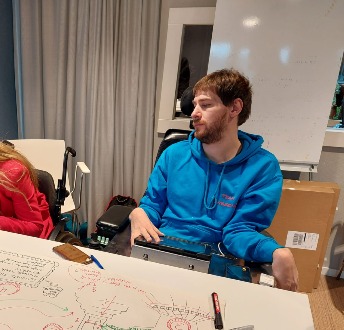
Leon, you live in ‘s Heeren Loo and have been involved as a co-researcher in this project for several years now. From your perspective, what are some of the biggest challenges you face as a wheelchair user in Groningen?
Leon Lodder: The old narrow streets.
If you could communicate one key message to urban planners and policymakers based on your experiences in the RolMaps project, what would it be?
Leon Lodder: Make all entrances accessible so that people with disabilities can more easily go shopping. Or can grab a drink or have a bite to eat with friends.
What do you want people to understand about people with disabilities?
Leon Lodder: That people don’t think that someone in a wheelchair is stupid. People always talk to the person who is accompanying me. Not to me.
Do you think people without disabilities know how to approach you?
Leon Lodder: No. They have no experience with people with disabilities.
What do you hope this project will achieve or bring about?
Leon Lodder: That shopkeepers understand what they can do for people with disabilities. That shopkeepers start taking it into account. That we can just do a normal, fun activity. Like being in a park or going to a shop on a Saturday. And transport. I am really dependent.
Julia, as a postdoctoral researcher on this project, what specific role do you play?
Julia Doornbos: My role is focused on public dissemination in line with participatory research traditions. Bettina has been working with students and co-researchers from ‘s Heeren Loo since 2015. I am currently assembling and analysing existing data collected from these arts-based research collaborations. Furthermore, I’m going back through all the materials with the people who collaborated, asking what this project has meant to them and what they took away from it. All these materials will be compiled and curated in a book, in collaboration with the same former art student Anna Lebedieva. We’re also working on an exhibition in connection to the book. It’s really a celebration of all that’s been created by those involved and the meaningful encounters established.
This is a question for all of you. What drew you to participate in Bettina’s research project? And what is it like working in such a collaborative and participatory setting?
Leon Lodder: It means that I can participate in society.
Julia Doornbos: I think what really stands out about this project is the trust and emotional labour it takes to make it work. Some of our co-researchers don’t go out that much, so being part of this research was sometimes challenging. Bettina has done an incredible job at creating that trust throughout the years —respecting boundaries while gently pushing people to try new things. She empowers everyone involved, whether it’s us or the co-researchers at ‘s Heeren Loo, to take risks, make mistakes, and grow. For the co-researchers, being part of a 'real' research project, going out to collect data, talking to shop owners—these are things they wouldn’t usually do. It can be a very empowering experience, even though it’s not always easy. There are challenges, like taxis not showing up or other unexpected situations, but in the end, there’s so much growth and learning for all of us. That’s what makes it all worth it.
Julia Munuera Garcia: I completely agree. This is exactly why I was drawn to this PhD—it’s the chance to work with people. In my PhD, I research topics such accessibility and mobility, and how these influence the everyday experiences of people with disabilities in urban settings, for instance by using walking interviews. There’s something deeply rewarding about seeing the impact and the personal growth that comes from the connections that arise in these situations.
| Last modified: | 14 November 2024 12.28 p.m. |
More news
-
24 March 2025
UG 28th in World's Most International Universities 2025 rankings
The University of Groningen has been ranked 28th in the World's Most International Universities 2025 by Times Higher Education. With this, the UG leaves behind institutions such as MIT and Harvard. The 28th place marks an increase of five places: in...
-
05 March 2025
Women in Science
The UG celebrates International Women’s Day with a special photo series: Women in Science.
-
16 December 2024
Jouke de Vries: ‘The University will have to be flexible’
2024 was a festive year for the University of Groningen. In this podcast, Jouke de Vries, the chair of the Executive Board, looks back.
